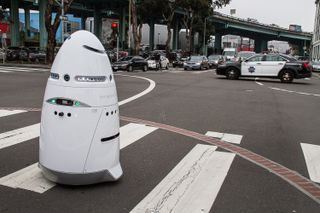7 futuristic security devices you can get right now
Part of the Idea Factory, our special report on innovation


1. Robotic security guard

Imagine: A guard that never calls in sick and doesn't loathe late-night shifts. Enter the Knightscope K5, a five-foot-tall, 300-pound robot that looks as though it rolled off the screen of a Star Wars film. The robot, Knightscope's creators say, is no different than camera-centric surveillance systems used by malls, school campuses, or grocery stores — except for the fact that the K5 is not stuck in a single location as it gathers data. What sets the K5 even further apart — aside from its R2D2-esque design — is that it syncs up with Knightscope's Security Operations Center, which alerts authorities if the robot senses a threat.
2. The smart bicycle pedal
Subscribe to The Week
Escape your echo chamber. Get the facts behind the news, plus analysis from multiple perspectives.

Sign up for The Week's Free Newsletters
From our morning news briefing to a weekly Good News Newsletter, get the best of The Week delivered directly to your inbox.
From our morning news briefing to a weekly Good News Newsletter, get the best of The Week delivered directly to your inbox.

French company Connected Cycle has developed a smart pedal to combat the all-too-common problem of bike theft. The pedal pings its owner's smartphone if the bike is touched. And even if a thief manages to speed off, an interior GPS system can continue to track the bike's location for authorities. There's little chance of thieves removing the pedal either, as it's only detachable with a special key. An added bonus? The pedal generates its own electricity, so it never needs a charge in order to sync up with a smartphone.
3. Remote-controlled robotic 'guard dog'

"Beware of the Dog" signs, whether there's a snarling Fido behind the fence or not, have been used as a low-cost security method for decades. Robotic spy dogs? Those are a more recent invention, although you can already find models for as low as $119. These remote-controlled robots are the size of a small dog, but unlike man's best friend, they come equipped with a camera, microphone, and speakers that can show an off-site owner with WiFi access exactly what's happening on the homefront.
4. Smart light bulb video surveillance
Sign up for Today's Best Articles in your inbox
A free daily email with the biggest news stories of the day – and the best features from TheWeek.com

A 2015 CES Innovation Award winner, smart lighting company Sengled is a bright new player on the home security front. The Sengled Snap light bulb can secretly sense movement or voices, and boasts a hidden 1080p security camera. The LED bulb can be used inside or out, and offers owners both real-time and playback views via connected smartphone.
5. Facial recognition 'passwords'

The days of trying to come up with a better password than "1234" or "83SmithStreet" could be nearing their end. Intel's new True Key app allows users to access all of their online accounts without relying on a single password. Instead, True Key uses facial recognition; users can then bolster their security further by adding a variety of additional "layers," such as fingerprint scanning and approved-device recognition. The app is still in limited release, but Intel has a waiting list for those who want to ditch the Name of First Pet / Number / Exclamation Point password soon.
6. Response FakeTV

The summer vacation season is especially ripe for burglars scouting out unoccupied houses, and while you may have a neighbor in charge of switching on your porch lights, too often, the dark interior is still a dead giveaway that nobody's home. FakeTV offers up a surprisingly simple solution. The small, electronic gadget automatically switches on at dusk, and emits a light that passes for the flickerings of a real television set. FakeTV uses even less power than a night light, meaning it's a much more energy-efficient bet than actually leaving your television turned on for a week.
7. The personal password bracelet

Toronto-based startup Nymi has taken the concept of user authentication straight to the source, with personalized, electrocardiography bracelets. These slim, lightweight bands analyze and store the wearer's unique heart rate, then use this "signature" to authenticate access to everything from smartphones to cars. The product is still in development, with the company expanding its applications all the time, by offering "developer kits" to individuals who want to add more account options to the band.
Andrea Jones is a freelance writer, blogger and contributor from Santa Fe, New Mexico. Andrea worked as a copywriter and editor for several years before becoming a freelance writer, and her specialist subjects include technology, business, health and youth addiction.
-
 What's at stake in the Mahmoud Khalil deportation fight?
What's at stake in the Mahmoud Khalil deportation fight?Talking Points Vague accusations and First Amendment concerns
By Joel Mathis, The Week US Published
-
 Why is a new Air Force One taking so long to build?
Why is a new Air Force One taking so long to build?The Explainer Trump may look for alternatives for his new plane
By Joel Mathis, The Week US Published
-
 New and notable podcasts for March
New and notable podcasts for MarchFeature The MeidasTouch Podcast and The Magnificent Others With Billy Corgan
By The Week US Published
